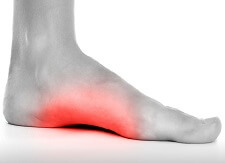- Home
- Diagnosis Guide
- Foot Lumps
- Lump On Bottom Of Foot
Bump On Bottom Of Foot
Written By: Chloe Wilson BSc(Hons) Physiotherapy
Reviewed By: FPE Medical Review Board
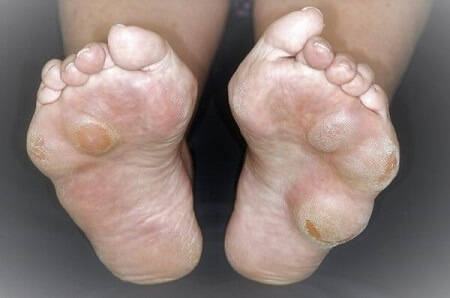
A bump on the bottom of the foot is a common problem that can cause pain, discomfort, or difficulty walking.
There are many possible causes of a lump under the foot, including skin issues, soft tissue growths, bone problems, and infections.
Understanding what type of lump you have is the first step toward proper treatment which may include orthotics, exercises, medications, injections, or surgery. Some bumps resolve on their own, while others require professional care.
In this guide, we cover common causes of a bump on bottom of foot, symptoms to watch for, how doctors diagnose foot lumps and effective treatment options.
Quick Overview
A lump under the foot can come from:
- Skin Thickening: calluses, warts
- Soft-Tissue Growths: plantar fibroma, ganglion cyst
- Nerve Issues: Morton’s neuroma
- Bone Changes: bone spurs
- Infections: or inflammatory conditions
- Less Commonly: systemic medical issues such as diabetes
If you are more bothered by pain than lumps and bumps on the bottom of the foot, check out the Ball Of Foot Pain or Foot Arch Pain articles.
Causes Of Bump On Bottom Of Foot
Foot lumps can appear in the heel, arch, or ball of the foot, and may be soft, firm, painful, or painless. The conditions most likely to cause a bump under the foot are:
1. Plantar Fibroma
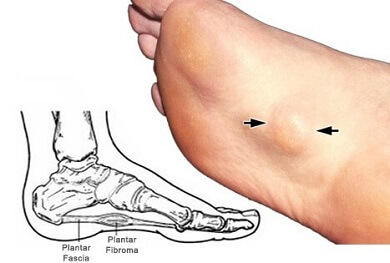
The most common cause of a lump in the arch of the foot is a plantar fibroma.
Plantar fibromas are small, firm nodules that develop in the plantar fascia, the thick band that runs under foot arch.
Symptoms: firm, rubbery immoveable lump in the arch; typically painless but can feel like a pebble when walking. Slow growing
Causes: Genetics, foot injuries, repetitive strain or medical conditions. Men are twice as likely as women to develop plantar fibromas
Treatment: Orthotics, stretching, steroid injections or surgery if it causes discomfort.
Learn more in our full Plantar Fibroma guide.
2. Calluses
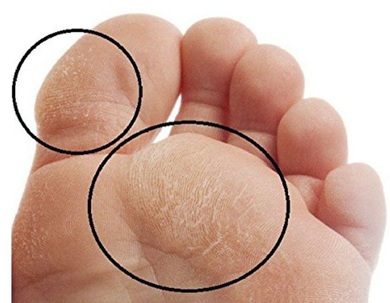
Calluses are thickened patches of skin caused by repeated friction or pressure, and are one of the most frequent causes of skin lumps under the foot.
Symptoms: Hard, raised lump in ball of foot or under the toes, generally painless unless irritated. Skin may appear yellow, dry or flaky.
Causes: repetitive friction, foot deformities, diabetes, tight footwear, high-impact activities
Treatment: Foot soaks, pumice stones, moisturizers and cushioned padding.
Learn more in our Foot Calluses section.
3. Bone Spurs
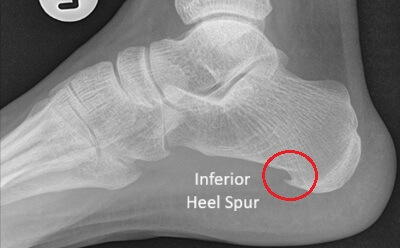
Foot bone spurs are areas of extra bone growth and are the most common cause of a hard lump on bottom of foot, usually on the heel or metatarsals.
Symptoms: Hard lump bottom of foot, sharp, stabbing pain when standing or walking.
Causes: Repetitive stress, tight shoes, injuries, arthritis or biomechanical changes.
Treatment: Exercises, orthotics, medication, and sometimes surgery.
See the Bone Spurs article for full treatment details.
4. Morton’s Neuroma
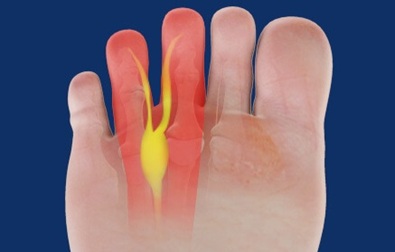
A Morton’s neuroma is a benign thickening of the nerve tissue, usually between the 3rd and 4th toes.
Symptoms: burning or tingling pain and lump in ball of foot, often described as like stepping on a pebble.
Causes: tight footwear, high heels, regular running or foot deformities. More common in women
Treatment: Shoe modification, orthotics, metatarsal pads, corticosteroid injections, or surgery.
Find out more in the Morton’s Neuroma article.
5. Plantar Warts
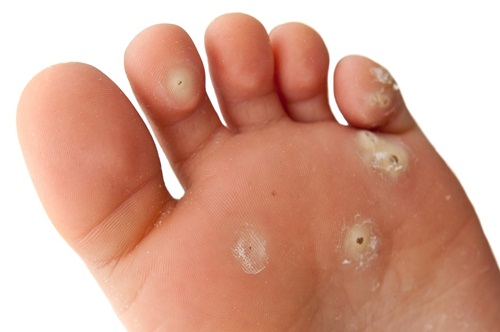
Plantar warts are common cause of skin lumps under the foot, aka verruca, caused by HPV virus infecting the skin.
Symptoms: small, thickened painful bump on foot, with black dots
Causes: HPV virus enters body through a break in the skin usually from walking barefoot
Treatment: Salicylic acid, cryotherapy, or minor surgical removal.
Find out more in the Plantar Warts article.
6. Dyshidrotic Eczema
Dyshidrotic eczema is a skin condition causing clusters or small, itchy blisters on the sole of the foot.
Symptoms: Tiny fluid-filled bumps under foot, burning or itching, redness, flaking or cracking skin.
Causes: Allergies, fungal infections, sweating or environmental triggers.
Treatment: Topical corticosteroids, moisturizers, antifungal treatments
Find more information in the Foot Eczema section.
7. Ganglion Cysts
A small, soft round lump underneath the foot may be a ganglion cyst. They tend to form around a joint or tendon.
Symptoms: Soft, fluid-filled lump under foot (1-4 cm), can cause pain and tingling if pressing on nearby nerves nearby
Causes: foot injury, joint or tendon irritation, repetitive stress
Treatment: Observation, aspiration, or surgical removal if symptomatic.
Find out more in the Ganglion Cysts article.
Other Causes Of Bump Under Foot
There are a number of other things than can also result in a bump on the bottom of the foot including:
- Gout Foot: Red, swollen, painful lump at bottom of foot, usually at base of big toe.
- Sesamoiditis: Inflammation of the small bones under the big toe, causing painful lump under foot
- Plantar Fasciitis: Irritation of plantar fascia can lead to heel bone spur
- Charcot-Marie-Tooth (CMT): Rare nerve disorder causing foot deformities and pressure lumps.
- Synovial Sarcoma: Rare malignant tumour. Urgent medical evaluation required for rapidly growing foot lumps
Symptoms to Watch For
A bump on bottom of foot may present with:
- Pain or tenderness while walking
- Hard, firm or soft lumps beneath the skin
- Redness, swelling, itching or warmth
- Round, flat, or irregularly shaped
- Blisters or fluid-filled bumps
- Difficulty fitting shoes over the bump
Seek urgent medical attention if the bump is:
- Rapidly growing
- Extremely painful
- Bleeding or infected
- Occurring with fever or numbness
- Not improving after 2–4 weeks
How Doctors Diagnose Foot Lumps
Any new bump on the bottom of your foot should be checked out by your doctor to ensure an accurate diagnosis.
Doctors typically start by taking a history, a physical examination and may use imaging tests:
- X-ray: To identify bone spurs or fractures.
- Ultrasound or MRI: To detect soft tissue lumps like fibromas, cysts or neuromas.
- Biopsy: If malignancy or infection is suspected.
Early diagnosis is important, especially for lumps that are rapidly growing, painful, or change in colour.
Bumps and lumps can develop anywhere on the feet and you may also be interested in the following articles:
#CommissionEarned from Amazon on qualifying purchases
Treatment Options
Treatment for a bump on bottom of foot depends on the underlying cause and often includes:
- Footwear and Orthotics: Wear supportive, well-fitted shoes to reduce pressure. Correct foot mechanics with supportive insoles and metatarsal pads
- Exercises and Physical Therapy: Stretching and strengthening exercises including plantar fascia stretches, heel stretches, foot strengthening exercises and calf strengthening
- Topical or Oral Medications: For pain, inflammation, or skin conditions
- Injections: Corticosteroids for plantar fibromas or neuromas
- Avoid Walking Barefoot: especially in public areas to reduce the risk of infection
- Good Foot Hygiene: keep feet clean and dry, and moisturise regularly
- Surgery: Reserved for persistent, painful, or malignant lumps.
Early intervention is critical for foot lumps and bump, especially for diabetic foot conditions
Prevention Tips
There are a number of things you can do to reduce the risk of developing lumps or bumps under your feet:
- Wear well-fitted, cushioned shoes
- Use padding or insoles to reduce pressure
- Treat skin issues early
- Avoid barefoot walking in public
- Check your feet regularly (especially if diabetic)
FAQ's: Bumps On Bottom Of Feet
People often have lots of questions if they find a bump on the bottom of their foot so here you will find answers to the 12 most common questions about lumps under the foot.
What Causes A Hard Lump On The Bottom Of My Foot?
What Causes A Hard Lump On The Bottom Of My Foot?
Hard lumps tend to form from pressure, repeated friction, or thickened scar-like tissue in the arch.
A hard lump on the bottom of your foot is usually caused by plantar fibromas or bone spurs. If the lump feels firm and sits in the arch, it’s most likely a plantar fibroma.
Hard lumps under the ball of the foot are often due to metatarsal overload or a deep callus, whereas a hard lump around the heel is likely from a heel bone spur.
Why Is There A Soft Lump Under My Foot?
Why Is There A Soft Lump Under My Foot?
A soft, squishy bump under the foot is often a ganglion cyst or lipoma. These lumps are usually fluid-filled, may change size, and often feel tender when pressed. They are usually painless unless they press on a nerve. Cysts may vary in size day-to-day, especially with activity.
What Causes A Lump On My Toes?
What Causes A Lump On My Toes?
A bump on bottom of foot by your toes is most likely due to a plantar fibroma, callus, or a bone spur.
If it is by your big toe, it is likely sesamoiditis or gout foot. If it is between your toes, especially in the middle of your foot, it is most likely a Morton’s neuroma.
What Is The Lump In The Arch Of My Foot?
What Is The Lump In The Arch Of My Foot?
A lump in the arch of the foot is most commonly a plantar fibroma, a firm nodule embedded in the plantar fascia. It may stay small or slowly grow. These lumps are non-cancerous but can become painful with walking.
Arch lumps can also be caused by cysts, tendon nodules, or lipomas, but plantar fibromas are by far the most frequent.
What Causes A Lump On The Ball Of The Foot?
What Causes A Lump On The Ball Of The Foot?
A lump in the ball of the foot often comes from metatarsal malalignment, leading to callus build-up over pressure points. Shoes with a narrow toe box and repetitive impact (like running) increase the risk.
If it is focused around the base of the big toe, it is usually due to sesamoiditis, irritation of the small pea-sized bones under the big toe. Other causes include ganglion cysts, plantar warts, and occasionally neuromas.
Why Do I Have A Painful Bump Under My Foot When Walking?
Why Do I Have A Painful Bump Under My Foot When Walking?
Painful bumps under the foot are usually linked to excess pressure, nerve irritation, or soft-tissue masses. Common causes include Morton’s neuroma, plantar warts, fibroma, inclusion cysts, and bony lumps.
If the pain gets worse in tight shoes or is associated with tingling, a neuroma is often the culprit.
Is A Lump On The Bottom Of The Foot Serious?
Is A Lump On The Bottom Of The Foot Serious?
Most bumps at the bottom of the foot are benign, but some need attention. A painful, fast growing, or very firm lump should be checked, especially if you have diabetes, circulation issues, or numbness. Lumps that ulcerate or don’t improve need a medical review.
When Should I See A Doctor About A Lump Under My Foot?
When Should I See A Doctor About A Lump Under My Foot?
See a doctor if the foot lump:
- Is painful
- Gets bigger
- Makes walking difficult
- Looks infected
- Occurs alongside numbness or diabetes
- Doesn’t improve after 2–4 weeks of home care
Can A Bump Under The Foot Be Cancer?
Can A Bump Under The Foot Be Cancer?
It’s extremely rare, but certain soft-tissue tumours can cause a bump on bottom of foot. Red flags include: rapid growth, severe pain, bleeding, or shape changes.
In most cases a bump on bottom of foot is completely benign, but persistent or unusual lumps should be checked.
How Are Lumps On The Bottom Of The Foot Treated?
How Are Lumps On The Bottom Of The Foot Treated?
Treatment depends on the cause but usually includes:
- Stretching & orthotics for plantar fibromas
- Shaving or padding for calluses
- Freezing or acid therapy for warts
- Aspiration for cysts
- Anti-inflammatory treatment for bursitis or joint swelling
- Footwear changes to reduce friction
- Physical therapy and exercises to stretch and strengthen
- Cryotherapy or salicylic acid for warts
Large plantar fibromas, cysts, or problematic bone spurs may require surgical intervention if conservative treatment fails.
Lump On Bottom Of Foot Summary
A bump on the bottom of the foot can come from skin thickening, soft-tissue growths or bone changes. Common causes include plantar fibromas, calluses, bone spurs, Morton’s neuroma, plantar warts and ganglion cysts.
Lumps may feel soft, firm or hard and can cause pain when walking or wearing shoes.
Diagnosis typically involves a physical exam and imaging such as an X-ray or ultrasound. Treatment depends on the cause and may include orthotics, footwear changes, stretching, medications, injections or surgical removal.
Seek medical advice if the lump grows quickly, becomes painful, looks infected, or does not improve after several weeks.
You may also be interested in the following articles:
Related Articles
References
- The Differential Diagnosis of Foot Lumps: 101 Cases Treated Surgically in North Glasgow Over 4 Years. Annals Of The Royal College Of Surgeons Of England
- Why Is There a Bump on the Bottom of My Foot? Verywell Health
- Bump on the Bottom of the Foot. Healthline
- Plantar Fibromatosis. National Library Of Medicine
- Plantar Fibromatosis. Radiopaedia.
Page Last Updated: 19th November, 2025
Next Review Due: 19th November, 2027
